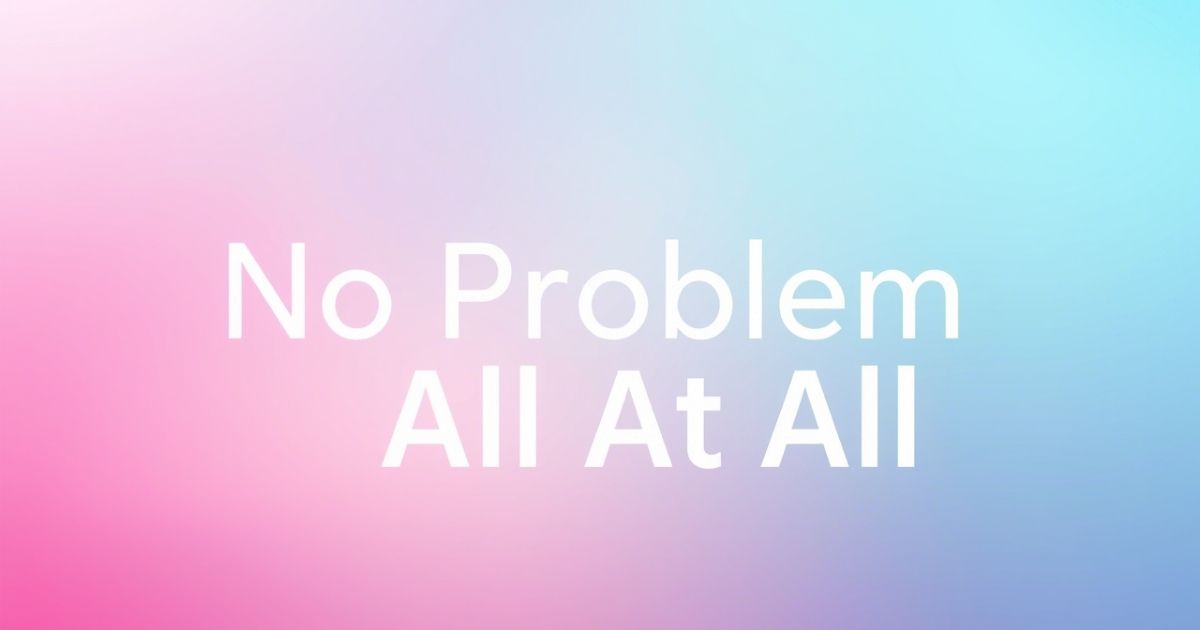No Problem at All – it’s a phrase we often use to show we’re happy to help. But sometimes, it’s nice to switch things up and sound a little more professional. You might wonder, what to say instead of no problem at all? Simple alternatives like “My pleasure” or “Glad to help” can work wonders.
When you need a more formal response, you can say, “I’m happy to assist” or “It’s no trouble at all.” If you want to sound more professional, try saying “Please let me know if you need further assistance.” Using these variations shows a supportive demeanor and can create a positive impression in work-related contexts. Remember, while no problem at all is a great casual phrase, mixing it with these options can make your communication even better!
Main Points
- “No problem at all” is a friendly, casual way to show you’re happy to help.
- In professional settings, it’s better to use phrases like “Glad to assist” or “It’s my pleasure.”
- Alternatives like “You’re welcome” or “Don’t mention it” work well in both casual and formal conversations.
- “No worries” and “No biggie” are relaxed responses best used in informal settings or among friends.
- Saying “It’s no trouble” or “Not an issue” keeps the tone professional and reassuring.
- Use tone variation and adapt your word choice depending on the situation and the relationship.
- Maintaining professionalism in work-related contexts helps create a positive impression.
- In casual conversations, phrases like “No dramas” or “It’s all good” help keep things easy-going.
- Always aim for a supportive demeanor and a stress-free interaction.
- Learning other ways to say no problem expands your communication repertoire and shows thoughtfulness.
You Are Very Welcome

When someone thanks you, responding with “You are very welcome” conveys warmth and appreciation. It’s a humble way to acknowledge gratitude and shows that you’re happy to have been of help. Whether in casual conversations or close relationships, this phrase offers a supportive atmosphere, leaving a positive impression. It’s informal and works great when you want to keep things relaxed and friendly, making the interaction feel effortless.
However, in a professional context, you may want to consider a more formal response. Saying, “It was my pleasure” or “I’m happy to help” sounds polished and respectful while still expressing the same sentiment. While no problem at all is commonly used in casual situations, using alternatives like “You’re very welcome” can help you strike the right tone in professional settings. Adjusting your word choice to the context helps maintain a smooth interaction.
Don’t Mention It
Saying “Don’t mention it” is a casual, easy-going response that signifies you’re happy to help, and there’s no need for further gratitude. It’s a way of showing humility, creating a relaxed and friendly atmosphere. This phrase works well in everyday conversations, especially with close colleagues or friends. It shows you’re not bothered by the favor and that the interaction was simple and stress-free.
For professional situations, it’s best to use a phrase like, “Glad I could assist.” This is still lighthearted but more polished, making it suitable for work-related contexts. While no problem at all is common in informal situations, using alternatives like “Don’t mention it” maintains the casual tone while keeping things smooth and friendly. However, it’s always important to adjust to the tone of the conversation and audience.
No Dramas
“No dramas” is an informal phrase that lightens the mood and shows that everything is under control. It’s a perfect response for casual settings, especially when you want to assure someone that the situation is easy to handle and there’s no need to worry. This phrase communicates ease, reassurance, and a relaxed attitude, creating a stress-free atmosphere. It helps maintain camaraderie and encourages further positive communication.
If you’re in a more professional situation, though, using “No trouble at all” or “It’s no problem” may be more appropriate. These alternatives keep the tone light but are polished enough for professional interactions. They offer the same reassuring sentiment as no problem at all, without sounding too informal. Adjusting your response based on the context is key to maintaining the right level of professionalism while still offering a supportive response.
No Worries
“No worries” is a laid-back and informal phrase that assures the person you’re helping that there’s nothing to stress about. It’s commonly used in casual relationships and among friends. This phrase adds a positive reassurance that the situation is easy and that you’re more than willing to help. It creates a supportive atmosphere where there’s no sense of tension or hassle.
In professional interactions, though, you might want to use “Happy to assist” or “Glad I could help.” These alternatives retain the same sentiment of helpfulness but are more polished for work-related contexts. Saying “No worries” might sound a bit too casual in formal situations, but finding the right words like no problem at all or “Happy to assist” helps convey professionalism while still being supportive.
You’re Welcome
The phrase “You’re welcome” is a standard and polite response to someone’s thanks. It’s a phrase that can be used in both casual and professional situations, as it strikes a balance between friendliness and professionalism. In casual conversations, this phrase communicates a sense of ease, making it a no-hassle way to acknowledge someone’s gratitude. It’s simple, direct, and versatile.
For work-related contexts, if you want to keep the same tone but add a little more polish, consider alternatives like “It’s my pleasure” or “I’m glad to help.” These responses express the same helpful attitude but with a more formal touch, making them perfect for professional interactions. Adjusting your response to the tone and setting, whether with no problem at all or a more refined phrase, ensures your communication is effective and appropriate.
It’s No Trouble

When someone expresses gratitude, saying “It’s no trouble” is a way to assure them that helping was easy and that you didn’t mind assisting them. This phrase creates a supportive and relaxed interaction, showing that the task was of no inconvenience to you. It works well in casual relationships and informal settings, creating a laid-back atmosphere where there’s no drama or stress.
In professional settings, however, saying “Glad to assist” or “It’s my pleasure” might be more appropriate. These alternatives retain the helpful and polite sentiment while sounding more professional. While no problem at all works well in informal settings, using phrases like “It’s no trouble” can make sure your responses are still warm and friendly, without losing the level of professionalism required.
Sure, No Problem
When you respond with “Sure, no problem,” you’re giving a confident and friendly reassurance that you are happy to help. This phrase conveys a positive, relaxed attitude, letting the person know that there’s no issue with assisting them. It’s commonly used in casual contexts where you don’t want to make a big deal out of helping.
In a more formal situation, though, you might choose a response like “I’m happy to assist” or “Glad I could help.” These options retain the same supportive sentiment but are more fitting for professional interactions. Using alternatives like no problem at all in these situations ensures your response is welcoming without being overly casual.
Related Guide:
12 Other Ways to Say “Thank You for Your Partnership”
Not an Issue
When you say “Not an issue,” you’re letting the other person know that helping them was simple and that there’s no inconvenience involved. It’s an easy-going response that helps put others at ease. This phrase works well in both casual and close relationships where you want to convey that there’s no hassle involved.
For a professional interaction, though, you might prefer “It’s no problem at all” or “I’m happy to help.” These responses are still informal but a bit more polished. By switching up your responses based on the context, you can ensure that your communication is effective, whether in casual or work-related settings.
No Hassle
Saying “No hassle” is a reassuring response that indicates helping out was quick and easy. It conveys a supportive and stress-free interaction, making it perfect for casual conversations where you want to keep things light and laid-back.
However, in more formal work settings, you may want to use “It’s no trouble at all” or “I’m glad to help.” These alternatives offer the same ease of interaction as no problem at all, but with a slightly more polished tone. Adjusting your language to suit the situation creates a smoother and more professional interaction, while still providing a helpful and encouraging response.
No Trouble at All
When you respond with “No trouble at all,” you’re letting someone know that helping them was easy and that you didn’t mind assisting. It’s a friendly and relaxed way to express that there’s no issue or inconvenience.
In professional situations, you can still use no problem at all, but alternatives like “Glad to be of assistance” or “I’m happy to help” might be more fitting. These phrases provide the same reassurance but with a touch more professionalism. By varying your responses, you can keep the tone appropriate for both casual and work-related contexts, ensuring smooth communication.
It’s All Good
When you say “It’s all good,” you’re offering a reassuring, laid-back response. It shows that everything is fine and there’s nothing to worry about. This phrase works well in casual relationships, making it perfect for informal conversations where you want to keep things stress-free. It’s a great way to reassure someone that there’s no issue or minor inconvenience, creating a relaxed atmosphere. It’s a simple, positive response that conveys ease and comfort.
However, in more professional settings, you might want to choose a response like “Everything’s fine” or “No issue at all.” These alternatives keep the tone professional while still offering reassurance. Using these variations instead of no problem at all ensures that your communication is more suitable for work-related contexts. By adjusting your word choice to match the tone and formality of the situation, you can maintain professionalism while still creating a supportive, stress-free interaction.
No Biggie

Saying “No biggie” is a casual, laid-back way of telling someone that their request or situation is no trouble at all. It implies that what they’re asking or what’s happening is very minor and doesn’t cause any inconvenience. This phrase works great in casual relationships, where you want to keep things light and fun. It’s an informal way to show ease and reassurance, making the interaction feel relaxed and without any pressure.
In a professional setting, though, you might want to opt for something more polished, like “Not a problem at all” or “It’s no trouble.” These responses convey the same supportive attitude but with a more professional tone. While no problem at all works in casual situations, using alternatives like “No biggie” can help you connect on a personal level, but adjusting your response in work-related contexts ensures a smoother, more appropriate interaction.
FAQ’s
What Does No Problem at All Mean?
No problem at all is a casual way to say you’re happy to help. It shows a relaxed attitude and reassures the other person.
How Do You Respond to No Problem at All?
A good response to no problem at all is a simple “Thank you!” or “I appreciate it.” It keeps the tone friendly and casual.
Is Saying No Problem at All Professional?
No problem at all can be informal. For professional interactions, phrases like “Happy to assist” or “It’s no trouble” are better choices.
Can You Use No Problem at All in Emails?
Yes, but in work-related emails, use more formal phrases like “Glad to be of help” to maintain professionalism and avoid overly casual language.
What Are Some Alternatives to No Problem at All?
Instead of no problem at all, try saying “My pleasure” or “Happy to help.” These alternatives keep communication smooth and professional.
Conclusion
No problem at all is a great, casual way to show you’re willing to help. It creates a relaxed atmosphere and puts people at ease. However, there are many alternatives that you can use depending on the situation. Whether you’re in a professional environment or a casual relationship, it’s important to adjust your no problem at all response. Phrases like “Glad to assist” or “It’s no trouble” can maintain professionalism while still showing a supportive demeanor.
If you’re looking for a more polished response, you might consider using phrases such as “Happy to help” or “Please let me know if you need further assistance.” These phrases can be used in professional interactions and help create a positive impression. Remember, the key is to match the tone of your communication with the context. With these alternatives, you’ll always have the right response, making no problem at all a flexible phrase in your communication repertoire.

Ember Rose is a dedicated administrator with 4 years of experience in efficient operations management and team leadership. Skilled in streamlining workflows and enhancing productivity.

